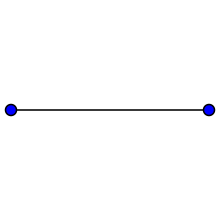Digon: Difference between revisions
ClueBot NG (talk | contribs) m Reverting possible vandalism by 59.167.180.218 to version by Addbot. False positive? Report it. Thanks, ClueBot NG. (1558763) (Bot) |
No edit summary |
||
| Line 64: | Line 64: | ||
*[[Hosohedron]] – a degenerate polyhedron with 2 vertices. |
*[[Hosohedron]] – a degenerate polyhedron with 2 vertices. |
||
*[[Demihypercube]] |
*[[Demihypercube]] |
||
*[[Vesica piscis]] |
|||
*[[Lune (mathematics)]] |
|||
==References== |
==References== |
||
*{{MathWorld |urlname=Digon |title=Digon}} |
*{{MathWorld |urlname=Digon |title=Digon}} |
||
Revision as of 15:34, 27 March 2013
| Digon | |
|---|---|
 A degenerate digon with two coinciding edges sharing the same vertices | |
| Edges and vertices | 2 |
| Schläfli symbol | {2} |
| Coxeter–Dynkin diagrams | |

In geometry, a digon or 2-gon is a polygon with two sides (edges) and two vertices. It is degenerate in a Euclidean space, but may be non-degenerate in a spherical space as a pair of 180 degree arcs connecting antipodal points.
In Euclidean space a digon is regular, because its two edges are the same length and its two angles are equal (both being zero degrees). It has Schläfli symbol {2}.
Some authorities do not consider the digon to be a proper polygon because of its degeneracy in the Euclidean case.
In spherical tilings
In Euclidean geometry a digon is always degenerate. However, in spherical geometry a nondegenerate digon (with a nonzero interior area) can exist if the vertices are antipodal. The internal angle of the spherical digon vertex can be any angle between 0 and 180 degrees. Such a spherical polygon can also be called a lune.
-
One antipodal digon on the sphere.
-
Six antipodal digon faces on a hexagonal hosohedron tiling on the sphere.
In polyhedra
A digon is considered a degenerate face of a polyhedron because it has no geometric area and edges are overlapping. But sometimes it can have a useful topological existence in transforming polyhedra.
Any polyhedron can be topologically modified by replacing an edge with a digon. Such an operation adds one edge and one face to the polyhedron, although the result is geometrically identical. This transformation has no effect on the Euler characteristic (χ = V − E + F).
A digon face can also be created by geometrically collapsing a quadrilateral face by moving pairs of vertices to coincide in space. This digon can then be replaced by a single edge. It loses one face, two vertices, and three edges, again leaving the Euler characteristic unchanged.
Classes of polyhedra can be derived as degenerate forms of a primary polyhedron, with faces sometimes being degenerated into coinciding vertices. For example, this class uniform polyhedron with octahedral symmetry exist as degenerate forms of the truncated cuboctahedron (4.6.8).
| Polyhedron | Cube | Truncated cube | Truncated octahedron | Octahedron | cuboctahedron | rhombicuboctahedron | Truncated cuboctahedron |
|---|---|---|---|---|---|---|---|
| Image | 
|

|

|

|

|

|

|
| Vertex figure | (2.4)3 | 3.8.2.8 | 2.6.4.6 | (2.3)4 | (3.4)2 | 3.4.4.4 | 4.6.8 |
In these pictures, the edges between red faces in the first two polyhedra and yellow faces the third and fourth can be seen as blue degenerate digonal faces {2}. In the cube, the yellow faces degenerate into points, in the octahedron, the red faces degenerate into points, and in the cuboctahedron the blue faces degenerate to points. This principle is used in the Wythoff construction.
See also
- Dihedron – a degenerate polyhedron with 2 faces.
- Hosohedron – a degenerate polyhedron with 2 vertices.
- Demihypercube
- Vesica piscis
- Lune (mathematics)
References
- Weisstein, Eric W. "Digon". MathWorld.
- A.B. Ivanov (2001) [1994], "Digon", Encyclopedia of Mathematics, EMS Press
{{citation}}: Unknown parameter|urlname=ignored (help)


